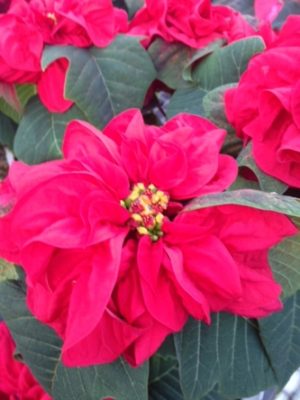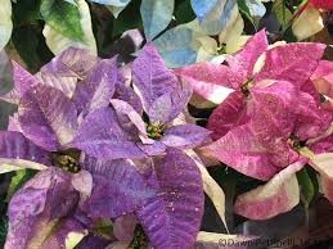Euphorbia pulcherrima
Poinsettias are perennial shrubs or small trees that are indigenous to Central America. Plants naturally grow along the western coast of Mexico and in deep canyons and tropical dry forests. They were used by the Aztecs as both medicinal and dye plants. The Latin name for poinsettia, Euphorbia pulcherrima, means ‘most beautiful’. Legends say that this plant became a symbol for Christmas because a community of Franciscan priests which settled in this area during the seventeenth century used this bright red plant during the Advent season to decorate their Nativity Celebration. Soon this became a tradition throughout Mexico.
Poinsettias were brought to the United States by the U.S. ambassador to Mexico from 1825 to 1830, Joel Poinsett. He sent cuttings to his South Carolina greenhouse and introduced poinsettias to his friends. It was not until 1920, however, that the first poinsettia variety was developed that could be successfully grown as a houseplant. The credit for this development goes to Paul Ecke, Sr. who went on to develop dozens of new cultivars including shades of orange, dusty rose, pink, creamy white and yellow. Also, plants hybridized by the horticulturists at the Paul Ecke Ranch in California were selected to be shorter, stockier and retain their bracts for longer periods of time under typical household conditions. Care of poinsettias is fairly easy.
The colored portions of the poinsettia are not the flowers but a plant part called a bract. Bracts are modified leaves. The actual flowers are the yellow cluster of buds in the center of a whorl of bracts. These flowers do not attract pollinators. When picking a poinsettia to bring home, select ones with the yellow buds not yet opened.
Location Requirements
During the winter months set them in a bright but indirect light. The ideal temperatures for poinsettias are between 60 to 70°F. Avoid drafts and excessive heat by keeping them away from doors and drafty windows and also from wood burning stoves and heaters. Poinsettia are not frost tolerant so do not leave them in vehicles or outdoors during the holiday season.
Water Requirements
Keep potting media moderately moist. Do not overwater poinsettias as this will encourage root rots. Remove foil coverings or plastic liners that do not have drainage holes and place pots on a saucer. A daily misting may benefit poinsettias where a home environment is dry.
Fertilizing and Reblooming
It is not necessary to fertilizer poinsettia that are only kept for the holidays. To get the plant to bloom again next holiday season wait until the bracts fade and then cut back the plant to a height of about 8 inches. Continue to water moderately and begin monthly fertilizing with a half-strength solution. New growth should be seen by May. Plants can be grown throughout the summer. Occasional pruning of the tips by pinching them off can be done from July to September: this will encourage branching. Transplant poinsettias into larger pots if necessary. Starting October 1st, keep the poinsettia in total darkness from about 5:00 p.m. to 7:00 a.m. and do this for 10 weeks. The bracts should begin to color up again in late November for another holiday season.
Varieties
Plants are bred or treated to be multi-branching and more compact than their natural shrub shape or grow as small trees known as standards. Red is the most popular color of bract followed by pink or white.
The ‘Winter Rose™’ series features red poinsettias with large, rose-like, multi-layered blooms. These ruffled novelty poinsettias are available in pink, white and marble (a lovely pink and white variegation). ‘Winter Rose™’ plants are a bit tall and stiff but the blooms are absolutely lovely in holiday arrangements combined with evergreen sprigs and red candles.

‘Fantasy’ poinsettias are available in sky blue, lavender, orange, turquoise or fuchsia, some even with glitter. These colors are spray painted on white poinsettias. Sometimes a spray adhesive is applied after painting to capture the fine, colored glitter for a shimmering effect. The paint may be water soluble so do not wet the leaves when watering the plant. If plant requirements are met for the poinsettia to rebloom next holiday season, it would be white.

The Princettia™ poinsettia hybrid features smaller, more compact plants with more branching and lots of smaller, colored, bract clusters. These work well as individual plants or in dish gardens.

Diseases and Pests
Poinsettia are susceptible to many bacterial and fungal diseases in the field but plants in a home environment are generally free of issues other than those related to improper watering.
Plant Toxicity
Poinsettias have mild toxicity for pets and humans. Poinsettia is in the Euphorbia family, and some parts contain a milky sap (latex) that can cause a skin irritation in some people. The milky sap may cause irritation to those with latex allergies and can irritate the mouth. All houseplants should be kept of the reach of children and pets.
Despite good cultural practices, pests and diseases at times may appear. Chemical control should be used only after all other methods have failed. For pesticide information or other questions please call toll free: 877-486-6271.
UConn Home and Garden Education Center, 2019